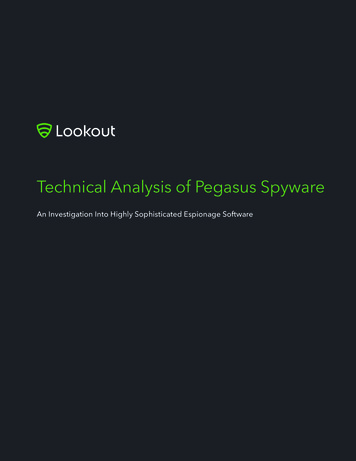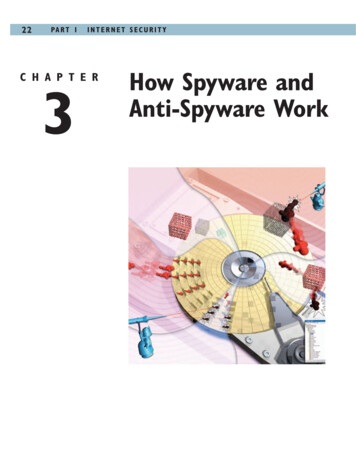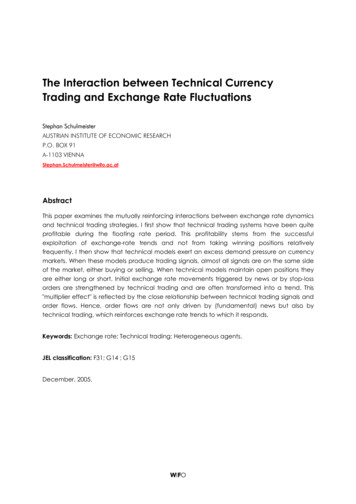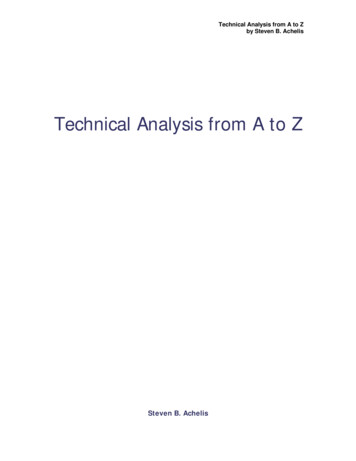
Transcription
Technical Analysis of Pegasus SpywareAn Investigation Into Highly Sophisticated Espionage Software
ContentsExecutive SummaryBackgroundDisclosure TimelineAttack OverviewProfessional Grade DevelopmentEvolution of SoftwareThe Trident VulnerabilitiesCVE-2016-4657: Memory Corruption in Safari WebkitCVE-2016-4655: Kernel Information Leak Circumvents KASLRCVE-2016-4656: Memory Corruption in Kernel leads to JailbreakJailbreak PersistenceSpyware AnalysisInstallation and PersistencePersistence: JSC Privilege EscalationDisabling UpdatesJailbreak DetectionDevice MonitoringStealth Update to Command & Control InfrastructureSelf DestructionData GatheringCalendarContactsGPS locationCapturing User PasswordsWiFi and Router PasswordsInterception of Calls and MessagesProcess Injection: converterSkypeTelegramWhatsAppViberReal-Time EspionageConclusionCreditsAppendix A: TLS Certificate InformationAppendix B: IOCs for Jailbreak Detection
Executive SummaryThis report is an in-depth technical look at a targeted espionage attack being actively leveraged against anundetermined number of mobile users around the world. Lookout researchers have done deep analysis ona live iOS sample of the malware, detailed in this report. Citizen Lab’s investigation links the software andinfrastructure to that of NSO Group which offers a product called Pegasus solution. Pegasus is professionally developedand highly advanced in its use of zero-day vulnerabilities, code obfuscation, and encryption. It uses sophisticated function hooking to subvert OS- and application-layer security in voice/audio calls and apps including Gmail, Facebook,WhatsApp, Facetime, Viber, WeChat, Telegram, Apple’s built-in messaging and email apps, and others. It steals the victim’scontact list and GPS location, as well as personal, Wi-Fi, and router passwords stored on the device. The iOS version of theattack uses what we refer to as Trident, an exploit of three related zero-day vulnerabilities in iOS, which Apple patched iniOS 9.3.5, available as of the publishing of this report.According to news reports, NSO Group sells weaponized software that targets mobile phones to governments and hasbeen operating since 2010, according to its LinkedIn page. The Pegasus spyware has existed for a significant amount oftime, and is advertised and sold for use on high-value targets for multiple purposes, including high-level espionage oniOS, Android, and Blackberry.This spyware is extremely sophisticated and modular, in addition to allowing customization. It uses strong encryption toprotect itself from detection by traditional security tools and has a vigorous monitoring and self-destruct mechanism.Lookout’s analysis determined that the malware exploits three zero-day vulnerabilities, Trident, in Apple’s iOS:1.CVE-2016-4657: Memory Corruption in WebKit - A vulnerability in Safari WebKit allows the attacker to compromise the device when the user clicks on a link.2.CVE-2016-4655: Kernel Information Leak - A kernel base mapping vulnerability that leaks information to theattacker that allows him to calculate the kernel’s location in memory.3.CVE-2016-4656: Kernel Memory corruption leads to Jailbreak - 32 and 64 bit iOS kernel-level vulnerabilities thatallow the attacker to silently jailbreak the device and install surveillance software.The attack sequence begins with a simple phishing scheme: send a text (or Twitter or other type of) message with abenign-looking URL, user clicks on link, open web browser, load page, exploit a browser or operating system vulnerability,install software to gather information and to ensure that the software stays installed on the device (“persistence”). As soonas the targeted victim clicks the link, the attack occurs silently, with no indication to the user or device administrators thatanything has occurred or that any new processes are running.The Pegasus software is highly configurable: depending on the country of use and feature sets purchased by the user ofthe spyware, the surveillance capabilities include remotely accessing text messages, iMessages, calls, emails, logs, andmore from apps including Gmail, Facebook, Skype, WhatsApp, Viber, Facetime, Calendar, Line, Mail.Ru, WeChat,Surespot, Tango, Telegram, and others.TECHNICAL ANALYSIS OF PEGASUS SPYWARE 3
Based on artifacts in the code, this spyware has been in the wild for more than two years. The exploits have configurationsettings that go all the way back to iOS 7, which was released in 2013 and superseded in 2014.Pegasus takes advantage of how integrated mobile devices are in our lives and the combination of features only availableon mobile — always connected (WiFi, 3G/4G), voice communications, camera, email, messaging, GPS, passwords, andcontact lists. As a result of its functional modularity, the breadth of communications and user data it monitors, and the tailored methods it instruments into other applications to exfiltrate data from them, to date, Pegasus is the most sophisticated privately-developed attack Lookout has encountered on a mobile endpoint. It hooks into widely used secure messenger applications to copy cleartext data out of them before the user’s app can encrypt and send it. From the perspectiveof the user and the people they’re communicating with, their communications are secure, while the administrator of thePegasus instance has secretly intercepted the clear text of their communication. Pegasus carries a high price tag averaging atover 25,000 per target. In at least one instance, NSO Group sold 300 licenses for 8 million USD.1This report presents the technical details of the attack from the beginning of the exploit chain to the end. It includesanalysis of the Trident zero-day iOS vulnerabilities that the toolkit was using to jailbreak the phone. We also look in-depthat the components of the espionage software, and have exposed the type of capabilities that an advanced mobile attacker using this software possesses.Trident (the vulnerabilities disclosed in coordination with this report) were present in the latest versions of iOS, up to iOS9.3.4, the latest iOS version as of August 2016 when we made these discoveries. Researchers from Lookout and CitizenLab responsibly disclosed the exploits and their related vulnerabilities to Apple. Given the severity of Trident,Apple worked extremely quickly to patch these vulnerabilities and has released iOS 9.3.5 to address them. With therelease of the patched OS, we are publishing the technical details of the attack and NSO-Group 0 4266323503.htmlTECHNICAL ANALYSIS OF PEGASUS SPYWARE 4
BackgroundAs mobile phones continue to be tightly integrated into our personal and work lives, malicious actors are actively creatingsophisticated applications that can run on victims’ devices without either their knowledge of the threat’s presence, or ofthe actors’ intent. This can be seen in the diversity of threats that target mobile devices: from those that are financially motivated, such as adware, banking trojans, and SMS fraud, to those seeking personal information or corporate intellectualproperty. Spyware, a malicious application designed to retrieve specific information from an infected device without thevictim’s knowledge, falls into the latter camp.Spyware applications often include the ability to extract a victim’s SMS messages, contact details, record their calls,access their call logs, or remotely activate a device’s microphone and camera to surreptitiously capture audio, video,and image content.In addition to these rich features, some spyware also has the equally important ability to remotely deliver the maliciousapplication to a target device. This is a complex and technically challenging problem, as evidenced by the amount ofmoney private security firms and corporate bug bounty programs pay for zero-day exploits that facilitate this remotedelivery.Two private security firms, Gamma Group and Hacking Team, both made headlines after media outlets revealed that theorganizations developed mobile surveillance software that has been sold to oppressive governments. These products areoften very expensive and generally only accessible to well-funded attackers given the complexity involved in creating thiskind of mobile spyware, and the fact that it includes zero-day exploits.The Israeli based NSO Group has managed to avoid the spotlight of the cyber security community despite being in operation for over five years. Founded in 2010 by Niv Carmi, Shalev Hulio, and Omri Lavie, NSO Group has publicly stated thatit develops and sells mobile phone surveillance software to governments around the world. It has claimed that its surveillance capability is undetectable with one of the founders stating, “We’re a complete ghost.” 2 Private equity firm FranciscoPartners acquired NSO Group in 2014 for 110 million. The founders of NSO Group play in both the cyber offense anddefense spaces, having also founded the mobile security company L ANALYSIS OF PEGASUS SPYWARE 5
Disclosure TimelineCitizen Lab reported the existence of the malware to Lookout on August 12, 2016. Lookout and Citizen Lab workedtogether to analyze the software and attempt to determine the severity of the vulnerabilities and the capabilities of themalware until August 15, 2016 when we reported the information to Apple.The three organizations worked together from August 15, 2016 to the release of the vulnerability patches in iOS 9.3.5 onAugust 25, 2016.TECHNICAL ANALYSIS OF PEGASUS SPYWARE 6
Attack OverviewThe attack is very simple in its delivery and silent in delivering its payload. The attack starts when the attacker sends awebsite URL (through SMS, email, social media, or any other message) to an identified target. The user only has to takeone action--click on the link. Once the user clicks the link, the software silently carries out a series of exploits against thevictim’s device to remotely jailbreak it so that the espionage software packages can be installed. The user’s only indicationthat anything happened will be that the browser closes after the link is clicked.The espionage software contains malicious code, processes, and apps that are used to spy, collect data, and report backwhat the user does on the device. This spyware can access and exfiltrate messages, calls, emails, logs, and more fromapps including, but not limited to: Gmail Facebook oit against SafariSurespotTangoTwo kernel exploits(CVE-2016-4655& CVE-2016-4656)jailbreak the deviceWhatsAppViberSkype1. Persistence and stealth monitoring2. Establishes communicationto Command & ControlInfrastructure3. Hooks all communicationand starts stealing dataTelegramKakaoTalkIn order to accomplish this, the spyware, once it jailbreaks the user’s phone, does not download malicious versions ofthese apps to the victim’s device in order to capture data, rather it compromises the original apps already installed on thedevice. This includes pre-installed apps such as Facetime and Calendar and those from the official App Store.Usually, iOS security mechanisms prevent normal apps from spying on each other, but spying “hooks” can be installedon a jailbroken device. Pegasus takes advantage of both the remote jailbreak exploit and a technique called “hooking.”The hooking is accomplished by inserting Pegasus’ dynamic libraries into the legitimate processes running on the device.These dynamic libraries can be used to hook the apps using a framework called Cydia Mobile Substrate, known to theiOS jailbreak community, and which Pegasus uses as part of the exploit.A user infected with this spyware is under complete surveillance by the attacker because, in addition to the apps listedabove, it also spies on: Phone calls SMS messages the victim sends or receives Call logsAudio and video communications that (in the words a founder of NSO Group) turns the phone into a 34-c7ac-11e2-be27-00144feab7de,Authorised false.html?siteedition intl& i location tl& i referer &classification conditional standard&iab barrier-app#axzz4I8PLStjS4TECHNICAL ANALYSIS OF PEGASUS SPYWARE 7
Access to this content could be used to gain further access into other accounts owned by the target, such as banking,email, and other services he/she may use on or off the device.The attack is comprised of three separate stages that contain both the exploit code and the espionage software. Thestages are sequential; each stage is required to successfully decode, exploit, install, and run the subsequent stage.Each stage leverages one of the Trident vulnerabilities in order to run successfully.STAGE 1 Delivery and WebKit vulnerability: This stage comes down over the initial URL in the form of anHTML file (1411194s) that exploits a vulnerability (CVE-2016-4657) in WebKit (used in Safari and other browsers).STAGE 2 Jailbreak: This stage is downloaded from the first stage code based on the device type (32-bit vs 64bit). Stage 2 is downloaded as an obfuscated and encrypted package. Each package is encrypted with unique keysat each download, making traditional network-based controls ineffective. It contains the code that is needed toexploit the iOS Kernel (CVE-2016-4655 and CVE-2016-4656) and a loader that downloads and decrypts a packagefor stage 3.STAGE 3 Espionage software: This stage is downloaded by stage 2 and is also based on the device type (32-bitvs 64-bit). Stage 3 contains the espionage software, daemons, and other processes that are used after the device has been jailbroken in stage 2. Stage 3 installs the hooks into the applications the attacker wishes to spy on.Additionally, stage 3 detects if the device was previously jailbroken through another method and, if so, removesany access to the device that the jailbreak provides, such as via SSH. The software also contains a failsafe to removeitself if certain conditions are present.The third stage deploys a number of files deployed in a standard unix tarball (test222.tar), each of which has its own purpose (that we describe later in this report): ca.crt - root TLS certificate that is added to keystore (see Appendix A) ccom.apple.itunesstored.2.csstore - Standalone javascript that is run from the command line at reboot and is used torun unsigned code and jailbreak the kernel on device reboot converter - injects dylib in a process by pid. It is a renamed version of the cynject from the Cydia open-sourcelibrary libaudio.dylib - The base library for call recording libdata.dylib - A renamed version of the Cydia substrate open-source library libimo.dylib - imo.im sniffer library libvbcalls.dylib - Viber sniffer libwacalls.dylib - Whatsapp sniffer lw-install - Spawns all sniffing services systemd - Sends reports and files to server watchdog workerd - SIP moduleThe attack we investigated works on iOS up to 9.3.4. The developers maintain a large table in their code that attacksall iOS versions from 7.0 up to and including iOS 9.3.3. While the code we investigated did not contain the appropriatevalues to initially work on iOS 9.3.4, the exploits we investigated would still work, and it is trivial for the attackers to updatethe table so that the attack will work on 9.3.4.TECHNICAL ANALYSIS OF PEGASUS SPYWARE 8
One other unique property of this attack is that standard jailbreak detections fail to report that the device has been exploited. The attack and installation of the spying software is designed to be as silent as possible to the target.Professional Grade DevelopmentPegasus is well designed in terms of its modularity and efficiency. For example, the kernel exploits call upon magic tablesfor each of the platforms that map out kernel memory for each version and phone model. The mapping for iOS 9.2.1 onthe iPhone 6 is shown here:TECHNICAL ANALYSIS OF PEGASUS SPYWARE 9
Note that each function location in memory (as an offset from the base of the kernel) is mapped. Each of these will beused later in the kernel version.Additionally, the code is extremely modular, relative to other malware our researchers have encountered. We found common libraries and common formats with similar naming conventions. For example, the libwacalls (WhatsApp Call Library)and libvbcalls (Viber Call Library) use similar formats with similar function names and common standards. Unlike mostmalware authors, the code in Pegasus is clean and efficient, with evidence of professional and careful design.Finally, we see evidence of a robust quality assurance process for their development: even their first stage exploit contains both debugging and QA-specific functions of the type one would expect from an enterprise-class software development organization.Evolution of SoftwareThe malware has been in operation for well over a year, which has enabled it to develop a degree of software maturity,and as a result it is capable of exploiting multiple iOS versions. An excerpt from the magic table that maps addresses inthe kernel shows that the exploit supports versions of the phone from the iPhone 4s up to the iPhone 6s Plus.The kernel exploit includes checks that indicate that the exploit works against iOS 7 (which was released in 013):TECHNICAL ANALYSIS OF PEGASUS SPYWARE 10
The Trident VulnerabilitiesThe software contains multiple zero-day vulnerabilities, referred to here as Trident, used against iOS 9.3.3, each of which would haveworked against current 9.3.4 as of the date of discovery. With the 9.3.5 patches, these vulnerabilities will no longer work.CVE-2016-4657: Memory Corruption in Safari WebKitA memory corruption vulnerability exists in Safari WebKit that allows an attacker to execute arbitrary code. Pegasus exploits this vulnerability to obtain initial code execution privileges within the context of the Safari web browser.This vulnerability is complex and Lookout continues to work on analyzing this vulnerability and will publish additionalfindings as they become available.CVE-2016-4655: Kernel Information Leak Circumvents KASLRBefore Pegasus can execute its jailbreak, it must determine where the kernel is located in memory. Kernel Address SpaceLayout Randomization (KASLR) makes this task difficult by mapping the kernel into different and unpredictable locationsin memory. In short, before attacking the kernel, Pegasus has to find it.The attacker has found a way to locate the kernel by using a function call that leaks a non-obfuscated kernel memoryaddress in the return value, allowing the kernel’s actual memory location to be mapped.CVE-2016-4656: Memory Corruption in Kernel leads to JailbreakThe third vulnerability in Pegasus’ Trident is the one that is used to jailbreak the phone. A memory corruption vulnerabilityin the kernel is used to corrupt memory in both the 32- and 64-bit versions. The exploits are performed differently oneach version.This vulnerability is complex and Lookout continues to work on analyzing this vulnerability and will publish additionalfindings as they become available.Jailbreak PersistenceOnce the kernel has been exploited, both exploits perform similar tasks to prepare the system to be jailbroken: Disable kernel security protections including code signing Remount the system partition Clear the Safari caches (to help cover their tracks) Write the jailbreak files (including the main loader as /sbin/mount nfs)As a final step of stage 2, the exploit removes /etc/nfs.conf which triggers the file to load /sbin/mount nfs (which is thestage 3 jailbreakloader). Because /sbin/mount nfs is run as root, the code is run with full privileges.After stage 3 will be unpacked, Pegasus need to gain persistence on device reboot. So exploit replaces the systemdae-mon rtbuddyd with a copy of the jsc binary and creates a link to ascript that is similar to the exploit forCVE-2016-4657, which we will describe later.
Spyware AnalysisPegasus is one of the most sophisticated pieces of surveillance and espionage software that Lookout has investigated. Ithas a novel mechanism to install and hide itself and obtain persistence on the system. Once it is resident, it uses a number of ways to hide its communications and protect itself from discovery, and it hooks into a large number of the phone’sfunctions in order to gather data and intercept messages and calls.Installation and PersistenceThe spyware is installed during the stage 3 execution by running the lw-install binary. Lw-install sets up a few of the keystructures of the product, as well as establishes persistence across reboots (and has a few protective functions to ensurethat the software doesn’t accidentally brick the phone).The first thing that lw-install does is check the iOS version; it runs different commands depending on whether it is runningon iOS 9 or a previous version.If it is installed on iOS 9, lw-install runs “/sbin/launchctl load” on .plist files dropped into /Library/LaunchDaemons (whichis normally empty or used to hold launchd plists for jailbroken services, such as sshd). This will ensure that these files getlaunched and started on reboot.TECHNICAL ANALYSIS OF PEGASUS SPYWARE 12
If the OS is not iOS 9, the first thing that lw-install does is remove the following files:Then it startsNote that lw install appears to log to gPersistence: JSC Privilege EscalationPegasus implements its persistence mechanism through the use of a developer tool called “jsc” that is part of the iOSenvironment. Jsc is intended to allow users to execute javascript using the WebKit engine outside the context of a webbrowser.6 In this case, a memory corruption issue in the tool is used by Pegasus to attain persistence.As part of the installation process for persistence, the daemon rtbuddyd is replaced by a copy of jsc (which is a signedbinary and allowed to run code). On device reboot rtbuddyd will run and load --early-boot, which is a link to thecom.apple.itunesstored.2.cstore file. The com.apple.itunesstored.2.csstore file is structured similarly to the exploitfor CVE-2016-4657. This loads shellcode which is used to re-exploit the kernel each time that the system is rebooted andstart the running daemons. The execution flow of this code is:TECHNICAL ANALYSIS OF PEGASUS SPYWARE 13
Run the jsc script calling --early-boot Run the exploit that maps the kernel base Run the kernel exploit Spawn the main running daemons of Pegasus: systemd, watchdogdAs Citizen Lab mentioned in their report, Pegasus puts its own protection above all else. From the manual, as quoted byCitizen Lab:In general, we understand that it is more important that the source will not be exposed and the target will suspectnothing than keeping the agent alive and working.To this end, Pegasus has a large number of features that enable it to maintain its secrecy. It constantly monitors the phonefor status and disables any other access to the phone by previous/other jailbreaking software. Pegasus also contains acomplex self-destruct mechanism which completely removes it from the phone.TECHNICAL ANALYSIS OF PEGASUS SPYWARE 14
Disabling UpdatesThe Stage 3 loader ensures that the phone won’t receive auto-updates going forward:Jailbreak DetectionThe stage 3 loader also checks the device to see if it had been previously jailbroken:The software also checks during each startup:TECHNICAL ANALYSIS OF PEGASUS SPYWARE 15
Device MonitoringIn order to maintain its ability to run, communicate and monitor its own status, the software disables the phone’s “DeepSleep” HNICAL ANALYSIS OF PEGASUS SPYWARE 16
The software also keeps a close eye on the battery status of the current device:Additionally, the software monitors the current connection state and tracks which types of networks the phone is connected to, potentially in order to determine the bandwidth and ability to send full data across the network:Stealth Update to Command & Control InfrastructureThe software has multiple stealth communication channels. The systemd binary that Pegasus employs appears to use SMSDespite appearing as a legitimate password reset from Google, this message actually contains an instruction for Pegasusto update the command and control servers that it can communicate to. It appears Pegasus is capable of receiving fivetypes of instructions via SMS, with the instruction ID determined based on the last number of the verification code. Forexample, in the message above this is 9.This functionality appears to allow Pegasus to be updated out of band if http or https was not available. In the event C2infrastructure was taken down or unavailable, this functionality provides Pegasus with a lifeline to the actors controlling itwith instructions on where to find the new C2 servers. This functionality is unprecedented in spyware and provides theability for Pegasus to persist even when infrastructure is compromised or taken down.TECHNICAL ANALYSIS OF PEGASUS SPYWARE 17
The various message texts are below:note. These instructions mirror the structure and expected content of legitimate two-factor authentication messages identically. An example of an attacker-provided instruction via SMS (captured originally by Citizen Lab) can be seen below.Despite appearing as a legitimate password reset from Google, this message actually contains an instruction for Pegasusto update the command and control servers that it can communicate to. It appears Pegasus is capable of receiving fiveTECHNICAL ANALYSIS OF PEGASUS SPYWARE 18
Self DestructionThe Pegasus software has a highly sensitive self-destruct mechanism to ensure that the product is not discovered.When the software appears to be threatened, it will self destruct, removing its persistence mechanism (removing thecloned rtbuddyd and exploit com.apple.itunesstored.2.csstore described above).Pegasus will also remove all of its libraries (for example, the audio recording tools):Data GatheringAs Pegasus’ fundamental purpose is to spy on the owner of the phone, one of its main operations is to gather data. LineThe data- gathering functionality of Pegasus is among the most complete and comprehensive we have seen in any spy Kakaoware package. It gathers everything from obvious high-value data like passwords, contacts, and calendar entries to data WeChatfrom numerous social networks. The full list of data types gathered is long, so we will examine only how it grabs certain Surespotpieces of high- value data in order to show how the product works. Imo.imThe full list of apps is: Mail.Ru SMS/iMessage Tango Calendar VK Address Book Odnoklassniki Gmail - mail and attachments Viber - calls and messages Facebook - address book and messages WhatsApp - messages and calls Telegram - messages SkypeTECHNICAL ANALYSIS OF PEGASUS SPYWARE 19
CalendarAs high-value PII, the “systemd” process grabs each VCAL file from the calendar and sends it through a message:ContactsThe software also gathers contacts from the system, dumping the victim’s entire address book.TECHNICAL ANALYSIS OF PEGASUS SPYWARE 20
GPS locationPegasus also constantly updates and sends the location of the phone:Capturing User Passwords
WiFi and Router PasswordsIn addition to stealing all of the victim’s passwords, Pegasus interrogates the list of every Wi-Fi network that the phone hassaved and grabs all of the SSIDs and WEP/WAP keys and users.Pegasus also grabs the router password for Apple devices like Airport, Time Capsule, etc.TECHNICAL ANALYSIS OF PEGASUS SPYWARE 22
Interception of Calls and MessagesPegasus has a sophisticated set of audio and messaging intercept libraries that are modular and extensible. The baselibraries for audio (libaudio.dylib) and messaging (libimo.dylib) are comprehensive, but there are specialized libraries foreach of the key intercept protocols.The libaudio library registers a number of notification observers that record audio when fired. These observers listen fornotification IDs that get posted by various Pegasus modules. In the analyzed sample, this included notifications from theWhatsApp and Viber modules (, libwacalls.dylib and libvbcalls.dylib).Normal PhonePegasusInfected PhoneTECHNICAL ANALYSIS OF PEGASUS SPYWARE 23
notification IDs that get posted by various Pegasus modules. In the analyzed sample, this included notifications from theWhatsApp and Viber modules (, libwacalls.dylib and libvbcalls.dylib).Process Injection: converterThe interception of real-time calls from the chat messengers (e.g., WhatsApp, Viber) comes through a library that is injected into their process space dynamically at run time. The “converter” binary (the mechanism through which this occurs) is aversion of the cynject open-source library available here: nject.cppThe library takes a pid as an argument and injects a dylib into running process using Mach kernel APIs. The usage for converteris: start (usage: %s pid dylib [args.])Converter has the following entitlements: key com.apple.springboard.debugapplications /key true/ key get-task-allow /key true/ key task for pid-allow /key true/ Additionally, converter has a failsafe key combination that it listens for on the keyboard to dynamically unload the injectedlibraries.SkypePegasus pulls all of the data about calls out of the Skype database on the device.TECHNICAL ANALYSIS OF PEGASUS SPYWARE 24
Pegasus also saves any calls that Skype has previously recorded by reading them out of the Skype database files.TECHNICAL ANALYSIS OF PEGASUS SPYWARE 25
TelegramWhatsAppThe Pegasus authors have
TECHNICAL ANALYSIS OF PEGASUS SPYWARE 4 Based on artifacts in the code, this spyware has been in the wild for more than two years. The exploits have configuration settings that go all the way back to










